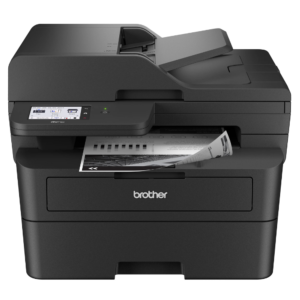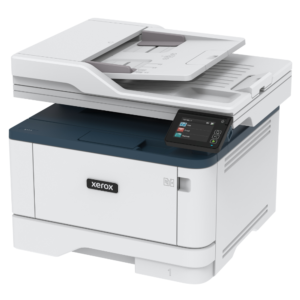Which UPS Do I Need for My PC? (Buying Guide + Suggested Models 2025)
Selecting the appropriate UPS for a personal computer requires careful consideration of power requirements, runtime needs, and system sensitivity. Users often overlook critical factors such as wattage calculation accuracy and the importance of pure sine wave output. The evolving market of 2025 introduces advanced UPS models that promise enhanced reliability and features suited for diverse PC setups. Evaluating these models carefully guarantees ideal protection, preventing potential data loss or hardware damage.
Understanding Your Power Requirements
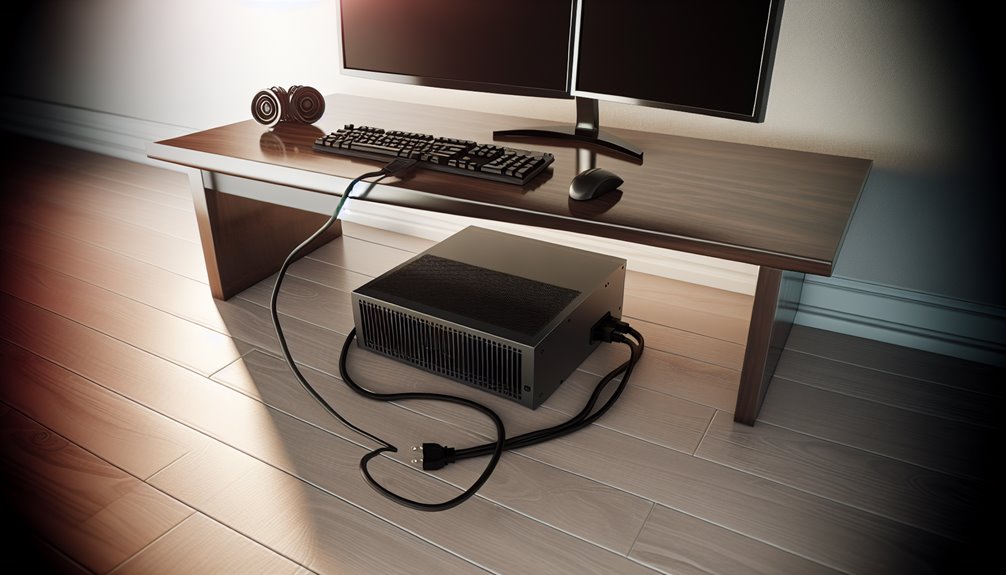
Selecting the appropriate UPS type, such as Online or Line Interactive, depends greatly on the user’s specific power stability requirements and equipment sensitivity.
An Online UPS provides continuous power conditioning and isolation from disturbances, making it ideal for critical, sensitive systems.
A Line Interactive UPS, while more cost-effective, offers basic voltage regulation suitable for typical home or small office computing environments.
Check out Computer UPS Prices in Sri Lanka for unbeatable offers.
Difference between Online UPS and Line Interactive UPS
Although both Online UPS and Line-Interactive UPS systems provide backup power during outages, they differ markedly in operation and suitability for various applications.
An online UPS continuously supplies power by converting AC to DC for battery charging, then back to AC, guaranteeing zero transfer time and delivering pure sine wave output ideal for sensitive electronics.
Conversely, a line-interactive UPS utilizes utility power directly, switching to battery only during outages or voltage fluctuations, offering a more energy-efficient approach but potentially providing modified sine wave output.
Key differences include:
- Transfer Time: Online UPS offers seamless shift; line-interactive UPS has brief transfer delay.
- Power Protection: Online UPS guarantees superior power protection for sensitive devices.
- Efficiency: Line-interactive UPS is cost-effective and energy-efficient for less critical applications.
Calculating UPS Capacity and Runtime
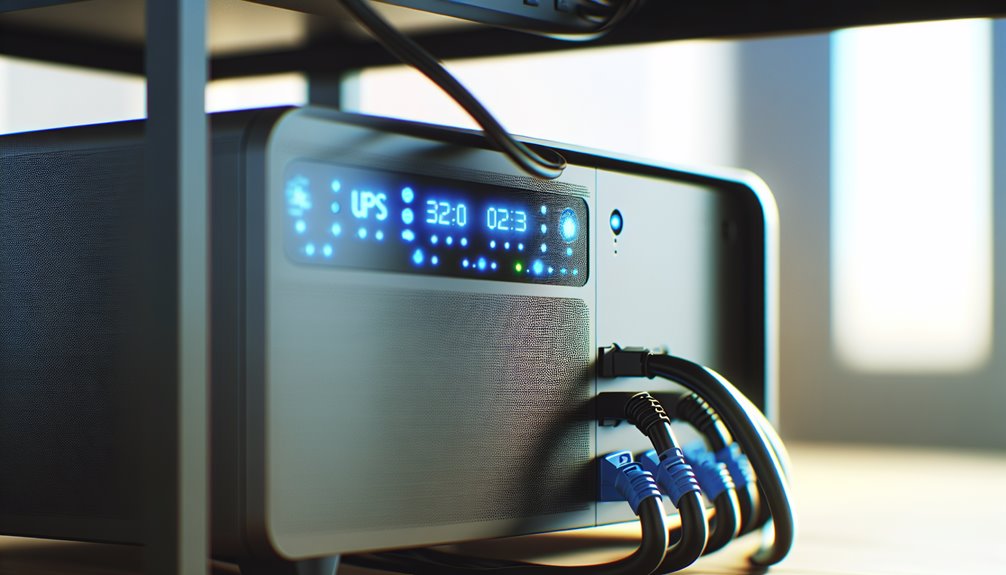
Before purchasing a UPS, users should accurately calculate the required capacity by summing the wattage ratings of all connected devices, including the PC, monitor, and peripherals.
Measuring actual consumption using a watt meter under typical load conditions provides the most accurate total wattage, ensuring the selected UPS will perform as expected.
To maintain peak performance and effective power management, it is recommended to choose a UPS with an output watt capacity 20-25% higher than the calculated total wattage, reducing the risk of overload during operation.
Additionally, users must consider the VA rating, which indicates apparent power. Understanding the ratio between watts and VA, known as Power Factor, helps evaluate UPS efficiency and compatibility with connected equipment.
Runtime—the duration the UPS supports devices during outages—varies considerably with applied load.
Users should consult manufacturers’ runtime charts to estimate how long the selected UPS will sustain their specific wattage requirements during power interruptions.
Key Features to Look for in a UPS

After determining the appropriate UPS capacity and runtime, users should evaluate specific features that guarantee excellent protection and performance for their equipment. Selecting the right features guarantees maximum protection for electronic devices and enhances reliability during power disruptions.
Key considerations include:
- Pure Sinewave Output: Pure sinewave output provides cleaner and more consistent electricity, making it ideal for sensitive hardware such as modern computers, NAS devices, and advanced peripherals. It prevents potential damage or performance issues caused by irregular power.
- Automatic Voltage Regulation (AVR): AVR guarantees stable output voltage, correcting fluctuations without switching to battery mode. This feature prolongs ups battery backup life by reducing unnecessary battery usage and safeguarding equipment from voltage irregularities.
- User-Replaceable Batteries and Adequate Outlets: Choosing a UPS with user-replaceable batteries extends equipment lifespan and reduces long-term costs. Verify the UPS has at least four battery-backed outlets to support all critical components during outages.
Top Recommended UPS Models for PCs in 2025

Selecting a reliable UPS for a PC setup in 2025 requires careful consideration of wattage capacity, runtime, and power conditioning features.
The DIP Line Interactive 650VA UPS offers essential protection and sufficient backup for basic home or office systems, while the DIP Line Interactive 1.2kVA UPS provides increased wattage and runtime suitable for more demanding personal or professional setups.
For robust protection and stable clean power required by high-end gaming rigs or critical workstation environments, the DIP 3kVA Online UPS stands out as a recommended premium choice.
DIP Line Interactive 650va Ups
The DIP Line Interactive 650VA UPS is a dependable choice for PC users seeking reliable protection against power interruptions and voltage fluctuations.
Providing a stable 390-watt power output, it effectively supports basic desktop configurations, including PCs and monitors, during brief outages.
Equipped with automatic voltage regulation (AVR), this UPS guarantees consistent voltage delivery, safeguarding sensitive electronics from harmful surges and instability.
Its compact form factor makes it ideal for home or office setups with limited space, while the user-replaceable battery contributes to extended lifespan and reduced maintenance expenses.
Key benefits include:
- Reliable battery backup guaranteeing safe PC shutdown during power outages.
- AVR technology stabilizing voltage and protecting devices.
- Compact design suitable for space-constrained environments.
DIP Line Interactive 1.2kva Ups
As power reliability becomes increasingly critical for advanced computing setups, the DIP Line Interactive 1.2kVA UPS stands out as a robust choice for safeguarding PCs against outages and voltage irregularities.
This uninterruptible power supply offers reliable automatic voltage regulation (AVR), maintaining stable voltage levels and effectively protecting connected hardware from voltage fluctuations.
With a pure sine wave output, it guarantees compatibility and safety for sensitive electronic components, reducing risk of damage from irregular power supplies.
The 720-watt capacity comfortably supports typical PC configurations, monitors, and essential peripherals, giving users sufficient battery life to save and safely shut down during power disruptions.
Additionally, multiple power outlets enable users to conveniently connect their entire workstation, guaranteeing thorough power protection and operational continuity.
DIP 3Kva Online Ups
For users seeking higher capacity and uncompromising power protection, the DIP 3kVA Online UPS emerges as a top-tier option among recommended PC UPS models for 2025.
Offering robust and reliable power protection, this 3Kva online UPS guarantees zero transfer time, providing uninterrupted power supply during outages. Engineered with pure sine wave output, it guarantees compatibility and peak performance for sensitive electronics, safeguarding longevity of connected devices.
Key advantages include:
- Automatic Voltage Regulation (AVR): Stabilizes voltage and protects against harmful surges, guaranteeing consistent power quality.
- High Capacity: Ideal for demanding PC setups; total connected devices’ power draw should be at least 20-25% below its wattage rating.
- Maintenance: Regular battery health monitoring and timely maintenance guarantee dependable long-term performance, preventing unexpected downtime.
Tips for Maintaining and Maximizing Your UPS Performance
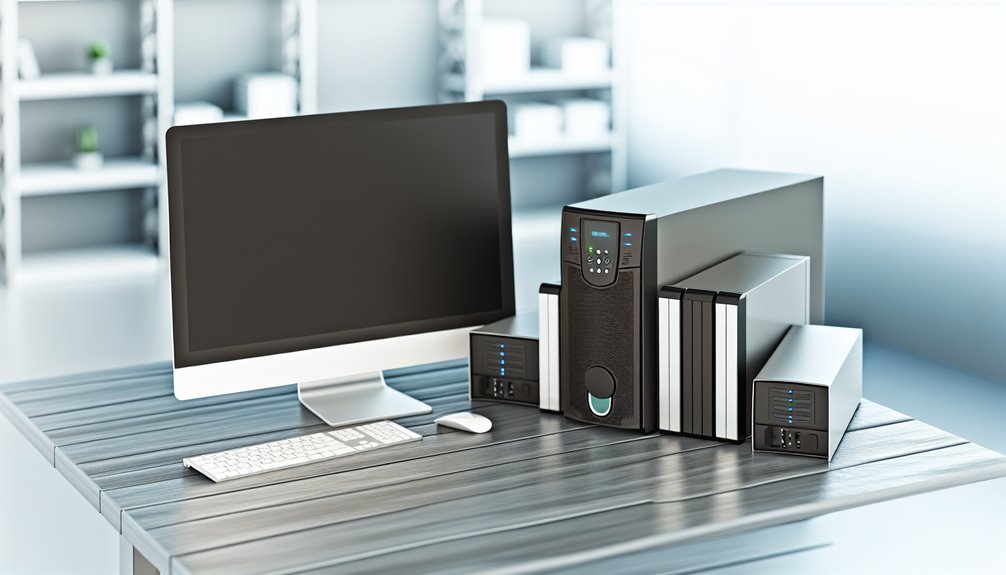
To guarantee a UPS delivers consistent performance and long-term reliability, users should regularly test its functionality by briefly disconnecting it from the main power source, confirming the device can sustain connected equipment during outages and evaluating battery health.
Users must closely monitor and manage their UPS unit by routinely using manufacturer-provided software tools to track battery power, runtime, and overall system health. They should replace UPS batteries every 3-5 years, as older batteries lose efficiency and may jeopardize backup capabilities, potentially risking important data.
Maintaining the connected load within 20-25% below the UPS’s maximum watt capacity helps prevent overloads, guarantees adequate runtime during outages, and prolongs device lifespan.
Additionally, proper positioning in a cool, dry, and well-ventilated area is essential to avoid overheating, which shortens battery life and compromises performance.
Following these practices helps guarantee sustained UPS effectiveness, safeguarding significant equipment and data against unexpected power disruptions.
Conclusion
Selecting the appropriate UPS involves thoroughly evaluating power demands and system sensitivity. Users with standard setups benefit from DIP’s 650VA line-interactive UPS, while advanced configurations needing clean power should opt for the DIP 1.2kVA pure sine wave model. High-demand or critical systems require the DIP 3kVA online UPS for zero transfer time. Regular maintenance, periodic battery tests, and keeping the load below 80% of UPS capacity guarantee prolonged reliability and peak performance longevity.


